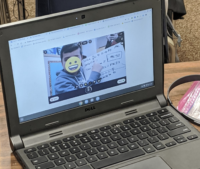
Educator and student technology proficiency has grown dramatically as a result of unprecedented rates of technology enabled distance learning that began in March 2020 due to the COVID19 global pandemic. And while it is encouraging to see students aged kindergarten through college adept at navigating computing devices and troubleshooting challenges, I have noticed that as schools begin to safely reopen their physical campuses, increased use of technology in classrooms can result in silent classrooms. As an edtech coach and promoter of student technology use, I am an advocate for student access to their own computing device. And yet, I am also a big believer in balancing no tech and low tech options, and ensuring students have the opportunity to speak about their learning.
Particularly as many students have been socially distanced and perhaps even isolated from those outside their family for over a year, communication and collaboration in classrooms is perhaps more important than ever before. Here are no tech, low tech, and high tech methods of fostering student talk in the physical classroom.
Content Commercials – Students benefit from the critical thinking skill of synthesizing recent content learning into a brief summary. Less is more, and reveals if students comprehended the gist, the main idea, of the content. Students can create a poster, google slidedeck, drawing, meme, or video as their content commercial. Be sure to provide learners the opportunity to verbally present their commercial – whether to a peer, or to the entire class via a video on a platform such as flipgrid. And be sure to give students a time limit. This maintains a healthy energy flow in the classroom and maximizes instructional minutes. Collaboration is key – if health guidelines allow students to work together on their content commercial, this may be ideal. If collaboration is not possible in your context, be sure that peer feedback is involved in the activity. Students can provide written or verbal feedback in flipgrid, or even on a post-it as they listen to a peers’ commercial.
Students as Teachers – It is said that the ability to teach proves mastery of a concept. Engage your students in teaching each other the content they are learning. Students can turn to a partner and verbalize their steps while writing on a white board for example, or use flipgrid to record their mini-lesson. Using flipgrid, students can even record their screen, annotate an image, and add text to their video. And even better, the platform allows students to respond to each other, to provide peer feedback via video or written text.
Technology is truly a powerful tool, but be sure to remember the power of student talk. Don’t be afraid to ditch the technology for a portion of a lesson to get kids sketching, speaking with each other about their visual representations of content, and making eye contact with one another. And when you do utilize technology – remember that its greatest impact is in documenting our humanness – our ability to express our learning verbally, with facial expressions, and to support each other socially. As you consider tech use in a reopened physical classroom, ask yourself – How can I leverage tech to get kids communicating verbally, and collaborating together?
